Juvenile Injustice
In his 2007 State of the City address, Mayor Michael Bloomberg announced that he will launch “the most significant restructuring of our juvenile justice system in decades,” including an increase in alternatives to incarceration, a crackdown on truancy, and a call to remove youthful offender status for those young people convicted of a crime involving a gun. “We're going to do more than ever to hold accountable the children and teens who run afoul of the law,” the mayor said, “and also help them get the services they need. “
One express subway stop up from City Hall, in a brownstone near Union Square with impressive doors and a well-kept stoop, Asadullah Muhammad has a mixed reaction.
“I’m glad there will be more services,” says Muhammad. “But his speech talks about holding young people accountable; it doesn’t talk about holding public officials accountable. Yes, young people need more services. They also need more opportunities.“
Muhammad runs Each One Teach One, or EOTO, a 15-week youth leadership program that trains and educates New York City teens who have been incarcerated, or are interested in reforming juvenile justice. The program is part of the Juvenile Justice Project, run by the Correctional Association of New York, a non-profit organization (housed in that Union Square brownstone) working for a more fair and humane criminal justice system.
It is a sad fact that young people who go to jail often boast about it afterwards. EOTO teaches youth to share their incarceration experiences as a teaching tool rather than a bragging right.
Listening to youth who have been incarcerated is becoming increasingly critical here in New York City, which since last year has had a more than 13 percent increase in the number of juveniles admitted to secure facilities maintained by the city's Department of Juvenile Justice. And it can bring about real change. "It's very powerful when you have youth who have navigated the juvenile justice system tell legislators and the City Council what's really going on behind the walls," said Muhammad.
Twice a week for 15 weeks, the 15 teens of EOTO are paid to learn about the injustices within the system, like the brutality that happens inside youth prisons. Once a year, they travel to Albany to speak to legislators face to face about specific bills and changes they want made. Some of what they have advocated coincides with what the mayor talked about in his speech:
Alternatives To Incarceration
The members of Each One Teach One have often puzzled over why only five of the 31 Office of Children and Family Services facilities are actually located in the city, when most of the kids confined in them are from the city. They were happy, Muhammad says, to hear the mayor’s commitment to “provide judges more options” for keeping youthful offenders “in the community – but out of trouble”, including “a $9 million initiative to reduce the number of kids sent away to Upstate facilities”, and a promise to provide more family-based and mental health services.
The young people of EOTO have actively lobbied to provide more money for "alternative to incarceration" programs. Research has found that these programs, like community service, cost less than detention and are more effective at reducing crime. New York State currently spends $150 million a year to lock up youth. But nearly half of these teens end up being rearrested and locked up again within a year, according to the 2006 Mayor's Management Report. "There's nothing for them to do when they get out, so they go back to what they're used to," said Rodney, 18, an EOTO team member (whose last name is being withheld because of his previous experience with the system).
Rodney was lucky. After being caught with a gun, he was sentenced to six months at CASES (Center for Alternative Sentencing and Employment Services), an alternative to incarceration program that provides juvenile delinquents with education, counseling, internships and job training under strict supervision. Because he missed 10 days of work at CASES, he was sent to jail at Riker's Island for a week. It was an experience, he says, that led him to promise himself never ever to go back there again.
Now, after going through CASES and finishing EOTO's 15-week program, he knows it is up to him to stay on track. Rodney plans to go to college for business management, and is waiting to hear back from several City University schools. "It takes self-control to be around the same surroundings you were in before you were arrested but keep yourself from being a part of it," he said, speaking, of course, from experience. "Even now, certain things happen and I feel myself getting ready to slip and I have to catch myself."
Youth Offender Status
The mayor also said he would ask Albany to “eliminate youthful offender status for any violent felony committed with a firearm…We have to face facts,” the mayor explained.“ More than 50 percent of all gun arrests involve young offenders. We have got to stop treating illegal gun possession among minors as though it were a trivial, youthful indiscretion. It is not.”
Muhammad disagrees with this proposal. “Youthful offender status doesn’t mean that an offender gets off scott-free. It just means it’s not necessarily hanging over their heads for the rest of their lives; they won’t have to put it on a job application decades later…Young people convicted of having a firearm don’t automatically get youthful offender status. It’s up to the discretion of judges. If you eliminate that discretion, then judges won’t have the opportunity or the motivation to pay attention to the specific needs, family situations and so on of individual young people.”
What Teens Need
The members of Each One Teach One explore how young people get stereotyped and misrepresented by the media, and how this has an impact on recommended policies. The teens themselves work to enact what they see as sensible policies. In one recent workshop, participants even learned how to write a press release and hold a press conference.
At last year’s Advocacy Day in Albany , EOTO teens asked the state legislators to provide more money for alternative to incarceration programs, and also to:
- Create an independent child advocate office in New York where jailed youth can call if they're being abused or need help. At the moment, the thousands of teens in detention in New York can only complain to one person who takes complaints for the whole state.
- Support a bill that would protect lesbian, gay, bisexual and transgender youth in the juvenile justice system from physical and verbal abuse. (It has since been voted down.)
- Support a bill to help get safe housing for teens who had been forced into prostitution. (Muhammad hopes this bill will be reintroduced and passed this year.)
Antoinette, 17, said EOTO, coupled with the 19 months she spent at Tyron Girls' Center near Albany, helped her pick a career. "I used to bark at my lawyers," she said, because they never seemed to defend her the way she wanted. And now? After learning to advocate on behalf of her incarcerated peers, "I want to be a lawyer to help people," she said, smiling. "That's my dream."
Tanisia Morris, 19, is a writer for New Youth Connections, a publication of our partner, Youth Communication. Â
50 Bullets, Many Issues

In the days since undercover police officers shot 50 bullets outside a strip club in Queens, killing 23-year-old Sean Bell on his wedding day and seriously wounding two of his friends, New Yorkers have experienced sadness, anger -- and deja vu.
Much about Bell's death and its aftermath have proved disconcertingly familiar. The victims were black. The police thought they had a gun, but like Amadou Diallo, Timothy Stansbury and others, they did not. None of the victims has been charged with a crime. Black leaders decried the police killing of another young unarmed black man. In response, lawyers for the officers and police unions offered testimonies to the character and professionalism of the (still officially anonymous) officers involved. And so on.
Many New Yorkers, particularly white New Yorkers, believe that much has changed in the city since the 1999 shooting of Diallo, an unarmed African immigrant killed in front of his apartment building. But what is striking about this case is what has not changed. That alone may be one of the biggest issues raised by the death of Sean Bell.
THE CASE
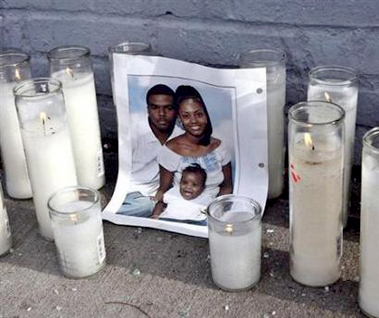
Much remains unknown about what happened in the early hours of Saturday morning, Nov. 25, outside the Kalua Cabaret in Jamaica. The two injured men, who remain hospitalized, have not issued public statements, and neither have other patrons of the nightclub.
What We Know
Bell, along with Joseph Guzman, 31, and Trent Benefield, 23, had been attending a bachelor party for Bell at Kalua Cabaret.
Apparently unbeknownst to them, the club was the target of an undercover police operation reportedly aimed at prostitution.
Sometime after leaving the club, the three men got into a car with Bell driving. According to Police Commissioner Ray Kelly's account, two undercover officers were in the bar and five outside.
Bell's Nissan neared an undercover officer, who was on foot, possibly striking him. The car crashed into an undercover police minivan and then backed up and hit a building, before shifting into forward, once again colliding with the minivan.
Police opened fire, unleashing 50 shots, 31 of which were by just one of the officers. According to the account by the police commissioner, four bullets struck Sean Bell, killing him; three struck Trent Benefield, at least 11 hit Joseph Guzman; the remainder hit a home, cars and a nearby Air Train platform.
What We Don't Know
A number of unanswered questions remain, including:
What made the police start shooting?
How many men were in Sean Bell's car? Last week police searched feverishly for a fourth man, but people in contact with Benefield and Guzman say they deny any such man exists.
Why did Bell drive so strangely? Was he trying to injure the officers? Or, as some have claimed, did he not know they were police and thought they were trying to attack him?
Was there a gun? None was found though police apparently think the alleged fourth man might have had a weapon.
The office of Queens District Attorney Richard Brown is investigating the case. A grand jury will have to determine whether the police acted reasonably in opening fire -- and whether Bell's death was a tragic mistake or a crime.
RACE RELATIONS AND THE POLICE
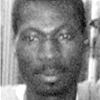 Ousmane Zongo |
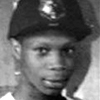 Timothy Stansbury |
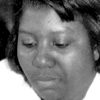 Alberta Spruill |
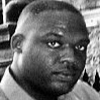 Patrick Dorismond |
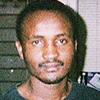 Amadou Diallo |
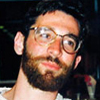 Gidone Busch |
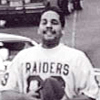 Anthony Baez |
 Sean Bell |
Race looms large over the Sean Bell killing, as it has over many of the controversial police killings of the last decade - and before as well. Amadou Diallo, Patrick Dorismond, and Timothy Stansbury were all black. In the last decade's most controversial police killings, only one victim, Gidone Busch, an Orthodox Jew, was white.
In the latest case, many commentators disputed that race played a role, noting that two of the officers involved are black and one Hispanic. Mayor Michael Bloomberg has said that, while the shooting seemed "inexplicable" and excessive," race did not appear to be a motive.
Few would say the police shot Bell simply because he is black. But many do maintain police treat black New Yorkers, along with Hispanics and other immigrants, differently than they treat white New Yorkers.
Racial Profiling
City Councilmember Letitia James sees a "suspension of the constitution in communities of color." On a recent visit to a city housing project, she said, she saw police confronting youngsters for riding bicycles or wearing bulky coats. Police, critics say, tend to view black men, particularly young men, perhaps wearing baggy pants, do rags and other street garb, as likely criminals.
Some police actions taken last week seemed likely to bolster such complaints. In an effort to find the fourth man they believe was in or near Bell's car at the time of the shooting, police raided several apartments in the Bronx and Queens and arrested at least six people. "Cops are hassling everyone in the complex," one man told the Daily News. "They're messing with poor people. They're trying to frame poor people."
"The police are getting desperate, said Kenneth Cohen, regional director of the NAACP Metropolitan Council. "The weapon is a fantasy." On Friday, he said the NAACP was continuing to receive reports that "the police are out in large numbers and dealing aggressively in the communities."
To confront such actions, the NAACP has proposed a national law to ban racial profiling that also includes funds to provide better police training.
The City Council passed its own anti racial profiling law after the Diallo shooting, requiring the police department provide statistics on the race of people they have stopped, questioned or frisked during the previous three months. But, the New York Civil Liberties charges that the police have not complied with that law since 2003. The police department has repeatedly denies it uses racial profiling.
James thinks a more diverse, better trained - and better paid -- police department would also better serve the city.
Civilian Complaints
In general, citizen complaints against the police have increased in recent years. The city's Civilian Complaint Review Board received 4,122 complaints against the police in fiscal year 2002. That rose to 7,373 2006, according to the Mayor's Management Report. But, the report notes, only 3.7 percent of the complaint filed were substantiated.
The city has argued that complaints have increased because it is now easier to file them because of systems like 311. The civil liberties union disputes this and is planning a detailed analysis of complaints.
Bloomberg's Behavior, Kelly's Conduct
"We all agree that there is a pattern of police abuse of power and this abuse of power ranges from police killing to police brutal behavior to disrespect. We reiterated that over and over again," Herbert Daughtry, a prominent Pentecostal minister, reportedly said following a meeting between Bloomberg and black leaders at City Hall last week.
That such a meeting took place seemed to indicate an improvement in the racial climate of the city and in police community relations from the days of Mayor Rudolph Giuliani. He did not meet with black leaders after Diallo's death and following Dorismond's shooting tried to attack the man's character. "Just the simple fact of meeting or discussion or expressing concern and outrage on the part of this administration was different," City Comptroller William Thompson told reporters last week.
Ray Kelly, who also served as police commissioner in the Dinkins administration, has had a generally good reputation in many parts of the city.
But following the Queens shooting, some critics questions whether Kelly - and by extension Bloomberg -- have done enough to improve the way police operate in minority neighborhoods. A few officials, notably Brooklyn City Councilmember Charles Barron called for Kelly's ouster. While few went that far, and Bloomberg stressed he would keep the commissioner, the shooting has hurt him with some onetime supporters.
"Ray Kelly's word is seen as good in a lot of our community but now his word is on trial," the Reverend Al Sharpton has said. "This is the greatest challenge of his career. It could result in Ray Kelly having a halo around his head or the undoing of a very popular image."
And many say if Kelly is culpable so is Bloomberg, who appointed him. "We are fed up with empty apologies, slippery explanations and dumb excuses. It's time for accountability at the top," Hazel Dukes, chairwoman of the state NAACP said in a written statement.
POLICE PRACTICES
Some degree of violence is inherent to police operations. At the same time many New Yorkers focused on the Bell shooting, a man stood trial in Brooklyn for the execution-style murder of two undercover police officers who were trying to get illegal guns off the streets. But while risks - to officers and to the community - can never be entirely eliminated, experts point to certain police procedures that may have contributed to Bell's death.
Special Units
In both the Amadou Diallo case and the Sean Bell case, the shooters belonged to an undercover special police unit, the street crime unit in the first instance, the club enforcement unit in the second. Rather than being assigned to a precinct, these plainclothes officers focus on a specific problem throughout the city - illegal guns, say, or problems at nightclubs
The fact that the cops are undercover and out of uniform creates risks for them and for others. No one knows that they are cops and so may run away or fight when confronted by them.
But the problems go beyond that. In the days of community policing, Councilmember Letitia James said, "A lot of the officers knew the players in a community - good and bad." But the special units, she continued, lack that familiarity and instead have an attitude that "these are our streets and we're taking them back"
"I don't think a beat cop would have fired" outside Kalua Cabaret, said Peter Moskos, a former Baltimore cop who now teaches at John Jay. "The old fashioned beat cop has a more accurate perception of danger."
To fight prostitution in this instance, uniformed officers posted outside could have discouraged soliciting from spilling out of the club and onto neighborhood streets. "There is nothing these officers did that an officer in uniform could not have done," Moskos said. But he added that police culture encourages the use of undercover units with standard patrols considered the bottom of the ladder, while assignment to a special unit is viewed as a promotion.
Politics encourages the special groups as well. The police department created the nightclub unit in response to the uproar over celebrated murders linked to the city's nightlife. The unit first worked in Chelsea, and after problems there abated, moved to the Kalua Cabaret.
In 2002, Ray Kelly disbanded the street crime unit. And last week, he announced that a committee would review procedures for undercover operations.
The 50 Bullets
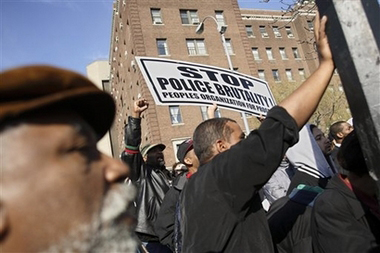
Many New Yorkers were as shocked by the sheer number of rounds fired at Bell as by the death itself. The barrage is largely due to the use of semi-automatic weapons, which the NYPD began issuing in 1986. But following the Diallo shooting, Ray Kelly wrote that the "barrage of police gunfire requires us to look back at how New York City police officers went from carrying virtually any weapons they wanted to the current high-capacity, semi-automatic pistols." There has been no reported discussion of such an examination now.
Police shoot to kill - not to disable people or to warn them. Experts attribute this to the danger posed by a wounded suspect and note that in real-life - unlike the movies - police can't simply shoot a gun out of someone's hand. "This is not the Old West," one former New York state police investigator once explained.
A hail of gunfire may arise out of the chaos and confusion surrounding an incident such as the one in Queens. Some police experts have attributed the barrage to "contagious shooting" - one officer opens fire and others, afraid the first faced a threat, follow suit.
The Frequency of Gunfire
The New York Civil Liberties Union said the number of shots fired by New York City police increased sharply from 2004 to 2005. Donna Lieberman said she was not sure why this is the case but thought it might spring partly from a "siege mentality" on the part of the police, which is also seen in some anti terrorism activities and the increased police presence in schools.
According to figures released by the department to Associated Press, though, New York City police are not trigger-happy. So far this year, they have killed 11 people, less than departments in some far smaller cities. In Las Vegas-which has about one-14th the number of police New York has - cops have killed 12 people in 2006.
And the level of shooting in New York has fallen sharply. Police fatally shot 54 people in 1973, 30 in 1996 and 9 in 2005.
"There's always a spotlight on the NYPD," Maki Haberfeld, a professor at John Jay College has said. "But in terms of actual numbers of shootings and their use of force, there's no doubt in my mind they are one of the best department s [in] the country."
Using Force
Whenever an officer uses a gun, questions surround whether that action is justified.
In this instance, one question has revolved around whether police should fire when facing a threat from a car. Official policy says no: Killing a driver of a moving car could pose an even greater threat to anyone in or near the vehicle. But many say this policy is unrealistic and sometimes ignored.
Generally, though, the issue comes down whether the police involved in a shooting faced a reasonable fear of death or serious injury. Police stress they do a vital, dangerous job and so must respond to genuine threats.
In the Diallo case, "the officer hunted a serial rapist whom Diallo resembled," Patrick Harnett, a former police officer wrote at the time. "Surely we want police to look for such a menace-who may have attacked 51 women-and we'd expect them to stop and question anyone who looked like him.... If the officers believed the suspect was shooting at them, wouldn't we expect them to shoot back?"
In the Queens shooting, even if the men in the car were unarmed, police had reason to be worried about the car, careening back and forth, according to Michael Palladino, Detectives' Endowment Association. "I do not think the amount of shots were excessive because there was deadly physical force used against our detectives and the detectives used deadly physical force back. They continued to fire until the threat against them ceased, " he has said. As in Queens, a police officer can fear death - even if the suspect does not have a gun. In the death of Gidone Busch, a jury agreed that the police had reason to fear - and fire 13 times at - the mentally ill man wielding a hammer.
The Judicial System's Response
The Bell case now rests with the Queens district attorney. But even if he seeks and wins indictments of one or more of the involved officers, a look at history reveals how difficult it would be to get a conviction.
Nineteen-year-old Timothy Stansbury, died one night in 2004 when he climbed the stairs to take a shortcut across the roof of his Brooklyn apartment development. Police officer Richard Neri Jr., was patrolling the roof with his gun drawn and shot the unarmed 19-year-old. A grand jury did not indict acquitted Neri.
Families of those killed from police have won financial settlements from the city government after filing suit. Earlier this year, for example, the city gave $3 million to the family of Ousmane Zongo, an unarmed man from Burkina Faso killed in a raid on a Chelsea warehouse - a raid that had nothing to do with him - in 2003.
Meanwhile, some are calling for other investigations. Councilmember Letitia James thinks a special agency should look into any fatality caused by police, much as the city now probes the circumstances involved when any child in its child welfare system is killed. She, the Civil Liberties Union and others also want Governor-elect Eliot-Spitzer, the current attorney general, and his successor Andrew Cuomo to launch an independent investigation of the shooting. Such a study should focus on police department policies that may have contributed to the shooting.
Noting that Spitzer conducted an investigation of the Diallo shooting, Donna Lieberman of the New York Civil Liberties Union said, "Unless the government takes this unwanted opportunity created by this terrible disaster and uses it to try to figure out in a meaningful way what's gone wrong, we can't hope to reduce the risk of this happening again."
Â
Teen Court Days
In a Manhattan courtroom, Hector Serrano asked to be discharged from foster care, though he is only 18 and could stay in the system until 21.
Susan Doherty, the referee, whose job is similar to a judge, agreed to this request. Then Hector Serrano had another: Could his brother live with him? “I feel I could be his foster parent.”
Doherty looked surprised. “Well, that is definitely your decision,” she said. “I mean, it would be difficult.”
One final request: Could he still visit his sister, who would soon be adopted?
Yes, she said, every two weeks from now on.
Case finished, Hector smiled, and looked proudly at his foster father and lawyer. He had been part of Teen Court Day at Manhattan Family Court – the one day every few months that Doherty sets aside for cases that only involve teens.
Because our parents do not have legal guardianship over us, children in foster care (as I was until recently) have regular involvement with family court. The court decides where we live, with whom, and for how long. The court also makes sure our privately owned foster care agencies are giving us the support and services to which we are entitled.
For all the court’s involvement in our lives, though, we are not especially encouraged to show up at court. The only times I ever went to court personally were for my siblings’ adoption, and my own. Instead, I went to my law guardian’s office once or twice a year and answered a series of questions. I do not think I even understood how my answers would be used in court, or what court dates meant for me. In retrospect, I wish I had been able to go in front of the judge while I was in care and been brave enough to tell her what was going on in the foster home I lived in for years.
Now, knowing that I could have attended my court dates, I wish I would have had a greater hand in making my own decisions.
More and more people agree that teens should have more of a voice in their own cases. A study last year by the Pew Commission on Children in Foster Care found that surprisingly few teens participate in court proceedings. It recommended that courts find ways to include teens in the decision-making on their own cases. The commission also created Home at Last, a non-profit advocacy organization, which has coordinated youth summits all over the country so that young people can tell system leaders why it is important that they have a voice in court.
But at New York’s Youth Summit, recently held at Fordham University, many teens in foster care explained why it has been difficult for them to do so. Some said it would be easier for teens to come to court if there was better transportation for them, or if they had peer educators who helped other teens know what is going on, or if the waits were not so long, or if the dates were not during school hours. As Ronnie Fuchs, director of the Office of Youth Development at the Administration for Children’s Services put it, “We tell you how important school is and then we screw it up by saying, â€Come to court at 11 a.m.’”
The lawyers seemed surprised by many things the teens said -- Erik Pitchal, director of Fordham University’s Interdisciplinary Center for Family and Child Advocacy, who organized the youth summit, was surprised at how strongly many foster youth want to be in court; Priti Kataria, a project attorney at Lawyers for Children, said she was surprised – and sad – “by how many teens didn’t seem to know who their law guardians were, or how to reach them”;Karen Fisher Gutheil, an attorney at Legal Aid, was the number of teens in foster care who had never been to family court, had not spoken to a judge, and felt that they had not really been able to express their opinions and wants directly. “A lot of the teens felt shut out from a process that is all about them.”
At the end of the summit, New York City’s foster care commissioner, John Mattingly, made a speech, promising us teens, “Your voices will be heard.” Pitchal said he plans to release a report including all the recommendations that came up that day. And Ronnie Fuchs said plans are in the works to make reforms in the court that will encourage youth to participate. “We are having conversations with family court people to make it easier for teens to come to court,” she said. “Things like changing the dates and times of court dates so they do not conflict with school, or setting up a teen center, so instead of a cold, sterile waiting room, you can use computers and there are things to do while you wait.”
She also said the Bronx Family Court will now have a Teen Court Day, as well.
This article by Natasha Santos, 18, a writer for Represent, is adopted from one that originally appeared on the pages of our partner, Youth Communication. Â
Bias Murder -- The Death Of Michael Sandy In Context
Twenty years after thousands of people marched with the Rev. Al Sharpton to protest the bias killing of Michael Griffith, a 23-year-old African-American New Yorker in Howard Beach, a similar killing this month of Michael Sandy, a 28-year-old gay African-American New Yorker, has produced no march through Brooklyn.
Sandy was attacked on October 8th at Plumb Beach. He fled his assailants, escaping onto the Belt Parkway, where he was struck by a car. His family took him off a respirator on October 13th. Three days later, there was finally a public expression of outrage, when mostly African American gay leaders held a press conference and vowed to work to change the “environment” in New York from which such crimes spring.
But how else to explain the relatively muted response to what Brooklyn District Attorney Joe Hynes has classified as a hate crime than to note how much the environment has changed in New York?
In 1986, New York State had no hate crimes law , allowing more severe penalties for assaults motivated by bias based on race, color, national origin, ancestry, gender, religion, religious practice, age, disability or sexual orientation. The bill, drafted in response to the Howard Beach incident, easily passed the Democrat-led Assembly but was held up by the Republican-dominated Senate for 14 years. The senators either rejected the notion that a bias attack was worse than any other attack, or they did not want to pass any bill that protected gay people as a class. The bill finally passed in 2000, followed by the Sexual Orientation Non-Discrimination Act in 2003.
Hynes, who was a special prosecutor in the Howard Beach case, was a prime mover of the hate crimes bill and is now using the law to prosecute the alleged perpetrators in the Sandy case.
A History Of High-Profile Bias Crimes
The 1989 racially motivated murder of Yusef Hawkins, a young African American, by a gang of whites in Bensonhurst was widely seen as one of the key reasons the city turned to Manhattan Borough President David Dinkins, a black man, to be mayor that year.
Dinkins himself was done in partly by what was seen as an inadequate response to the Crown Heights incidents in 1990 when masses of African Americans, incensed at the death of a black child, Gavin Cato, after being hit a Hasidic limo driver, rioted and Yankel Rosenbaum, a young rabbinical student, was killed.
Dinkins was succeeded by Rudy Giuliani, another mayor with a reputation as a polarizer and for siding with police in almost every dispute with communities of color. In 1997, Abner Louima, a Haitian man, was sexually abused by Police Officer Justin Volpe at a Brooklyn precinct house, sparking outrage. Volpe got 30 years and City Hall paid an $8.75 million settlement to Louima.
In 1999, when police from the Street Crimes Unit fired 41 bullets into Amadou Diallo , an innocent and unarmed African man in the Bronx, weeks of marches and demonstrations ensued and 1700 were arrested, with scores more getting arrested at police headquarters to demand the indictment of the officers who were eventually acquitted in a trial moved to Albany.
Mayor Mike Bloomberg tried to set a different tone on taking office in 2002, publicly meeting with Rev. Sharpton, also widely viewed as a polarizing figure and someone with whom Giuliani refused to meet. Giuliani, in fact, virtually never met with black elected officials including such relatively non-confrontational ones as Manhattan Borough President C. Virginia Fields.
This past June, several hundred gay people marched from the East Village site where African American drag artist Kevin Aviance had been assaulted coming out of a gay club. Police were quick to arrest suspects in that attack as they had been in the Sandy case--responses that helped mute community outrage in both instances.
Back in October 1998 when Matthew Shepherd , a gay, blond, slight 22-year old college student was brutally murdered by gaybashers in Wyoming, there was a nationwide response with a demonstration of more than 9,000 in New York that tied up traffic and led to scores of arrests. The aftermath of his death was dramatized by a play called “The Laramie Project” by Moises Kaufman that is now one of the most performed plays in the country by high school and college companies.
Why The Muted Response To Michael Sandy
The more muted response to Michael Sandy’s murder can be explained by a variety of factors, some less edifying than others:
First, police were quick in arresting the suspects.
Second, street activism in New York, save for some big anti-war actions in the last three years, is at an almost all-time low as people are more likely to agitate on the Internet than through public demonstrations.
Third, without minimizing the horrible crime against Sandy, he was reportedly tricked into thinking his assailant was someone like him seeking a sexual hook-up via the Internet. The sexual aspect of the case may have led fewer people to take up his case as a cause. While Sandy’s desire to meet for sex is shared by thousands of New Yorkers, the attack on him is a caution never to agree to an anonymous rendezvous in an isolated area. That the alleged perpetrators of the attack on him are believed to have gotten away with rolling other gay men in this way is a testament to the fact that such victims often still are afraid to go to the police and that gay liberation--even in New York--has a long way to go.
Fourth, some black gay bloggers, like Jasmyne Cannick , believe race and sexual orientation played a role in the lack of a response. She wrote that “we have the Black leadership that has basically looked the other way because Sandy was gay and then we have the gay leadership who has looked the other way because he was Black.”
Fifth, gay people have made great progress in recent years, including the election of Christine Quinn, an out lesbian, to the second most powerful post in the city, Speaker of the City Council. That kind of seat at the table gives the community a sense that officialdom will take care of it. Indeed, Mayor Mike Bloomberg said in the wake of Sandy’s murder, “this crime was a grave matter and was given immediate attention at all levels of city government.” He also affirmed, “New York is a city where diversity is celebrated and tolerance is practiced, and today we reaffirm our efforts and stand united to fight those who threaten those values.”
On October 16, the black gay leaders who protested Sandy’s murder didn’t take it to the streets, but to the steps of City Hall. Michael Roberson of the HIV/AIDS group People of Color in Crisis said that they needed to challenge “church, school and family norms about the value of black gay men’s lives.” Bishop Zachary Jones of the black and gay Unity Fellowship Church said, “We will not tolerate messages of hate from schools and pulpits.”
But for all the talk of changing the environment that fosters anti-gay bigotry such as that that killed Michael Sandy, most New Yorkers belong to religions that teach that homosexuality is sinful, even if a minority of religious leaders here use the kind of crude anti-gay language some fundamentalists are famous for. And Mayor Bloomberg refuses to implement the City Council’s 2004 anti-bullying law --calling it “illegal” and “silly." New York City’s schools do not even collect serious statistics on bullying incidents.
Clarence Patton, director of the Gay and Lesbian Anti-Violence Project of New York , put forth a four-point program to change the environment in New York, calling on the city to work on mitigating hate violence “between major hate crimes,” encouraging survivors of such crimes to come forward and making more services available to them, and developing strategies for gay people that will “result not only in our taking responsibility for our own safety, but that of others in the lesbian, gay, transgender and bisexual community.”
Â
Foreign, Battered and Denied Aid Unconstitutionally
It is an all-too-typical scenario: An immigrant woman has been battered continuously by a spouse. Now he has abandoned her, or she has escaped from their home, and she is indigent. The twist is that he is a legal immigrant, but her legal status depended on her relationship to him. She has no one to turn to for support except the government.
But in New York that support has not been forthcoming, according to the findings of federal Judge Jed Rakoff of the Southern District of New York, in a case known as M.K.B. vs. Eggleston.
"It is not the policy of the United States or the State of New York to leave destitute the battered immigrant wives and children of lawful U.S. residents just because their abusive husbands are no longer supporting them or providing them with a basis for obtaining aid," Rakoff wrote in his 83-page decision, but “just such dire consequences are occurring….” Both New York City and New York State, the judge ruled, have been violating the rights of the plaintiffs in the case (and others in the same situation) through a lack of oversight, computer foul-ups, failure to train staff, distribution of materials that misstated the law, and failure to take remedial steps when learning of these breaches.
The 13 plaintiffs in the case, according to attorney Scott Rosenberg of the Legal Aid Society, include the Jamaican woman known by her initials, M.K.B., who was eight months pregnant when her husband threatened to kill her with an ice pick, and to feed rat poison to the children. Another plaintiff from Jamaica, “LW”, was raped by her husband when she did not comply with certain sexual demands. “Ms. Diongue” from Senegal was tortured for five hours by her sister's boyfriend who had just strangled and murdered her sister. “Al” from Bangladesh had a husband so jealous that he assumed that by going to work she was sleeping with other men; he hit her and threatened to kill her, and then threw her out of the home, but would not let her take their baby daughter.
What the findings in the case establish is that benefits are routinely denied to women such as these because the applicants lack documentation in the form of social security numbers, green cards or other indications of legal status. Yet, the law’s purpose is to provide for the health and safety of vulnerable women and children whose supposed protectors were instead their tormentors.
Training manuals and other materials omit abused or battered qualified applicants from lists of immigrants eligible for state public assistance and Medicaid, and for federal food stamps. Workers did not know how to deal with situations where some members of a family were eligible and others were not. They did not understand and were not trained to work with the specific abused immigrant population under the "battered alien" provision of law, which gives rights and benefits to abused women and children who are not legal residents of the United States to which they would not otherwise be entitled. Even when city and state policy makers were made aware of the rampant problems, "no meaningful corrective action was taken."
Welfare workers were repeatedly told in writing and at training sessions, of the requirement that applicants present a social security card, when that was in clear violation of law. The same applied to green cards, citizenship papers, which are also not required, and the special exemptions under the Violence Against Women Act. A question that benefit workers would have to answer was: "Does there appear to be a substantial connection between the battery or extreme cruelty and the need for the benefits sought?" Yet there were no standards to apply and thus no way to assure that the decisions by the staff were not subjective and arbitrary. Moreover, if the worker miscoded a file, say, checking off "citizen" when that was incorrect, the applicant could later be charged with fraud, worsening the problems she came to the center with.
In unambiguous language, the court cited the city with "deliberate indifference," found that policymakers knew "to a moral certainty" that its employees would confront the types of situations at issue and performed in a manner that violated law and the Consitution. The Federal District Court for the Southern District of New York has found that the plaintiffs and all others similarly situated were "erroneously denied public assistance, Medicaid benefits and/or food stamps in violation of their federal and state rights.”
The plaintiffs were represented by the Legal Aid Society (with Hughes Hubbard and Reed), the City of New York by Corporation Counsel, and the State by the Attorney General.
Emily Jane Goodman is a New York State Supreme Court JusticeÂ
Subway Searches
As a deterrent to terrorist attacks on a "prime target," subway searches of passengers' bags are constitutional, according to a decision by a federal appeals court, and the searches will be allowed to continue.
The court rejected a lawsuit known as Brendan MacWade against New York City/NYPD, in which the New York Civil Liberties Union argued on behalf of five individuals include MacWade that the searches violated the 4th Amendment to the Constitution which prohibits unreasonable searches. The lawsuit also claimed that the searches have not been shown to be effective, and that there is no imminent threat of attack. The appeals court, however, agreed with the defendants and the trial judge, that this is a "special needs" case -- "protecting mass transportation facilities from terrorist attack" -- and therefore reasonable and lawful.
It is the city's position that the searches are voluntary because anyone who does not wish to have a bag search is not searched. But that person cannot enter the subway. The five plaintiffs (MacWade, Andrew Schonebaum, Joseph E. Gehring, Jr., Partha Banerjee and Norman Murphy) either consented to a bag search or refused consent and were therefore not allowed to enter the subway.
In addition to the argument that the search is voluntary, the court found that there are sufficient built-in safeguards against unreasonable searches to protect the privacy of riders. The searches are conducted at various checkpoints which are not disclosed in advance. They are random, meaning every fourth or eighth person (or whatever the number is that day) is stopped. The searches were considered non intrusive because they are of bags and parcels, not people, and do not involve looking into small objects that do not appear to be dangerous.
But danger was the theme of the two-day non-jury trial that lead to this appeal. The city called three experts on terrorism and on the subway system. Based on their testimony, a history of the system and of terrorism, the Circuit Court concluded that the search program "serves a paramount government interest."
The court found that the expert testimony established that the searches "have created an environment in New York City that has made it more difficult for terrorists to operate." At the same time, the decision points to previous plots to bomb the subway that defendants say they thwarted. Similarly the judges held that the New York Police Department "designed the program chiefly to deter terrorists from carrying concealed explosives onto the subway system and compared it with searches at airports and public buildings.”
Based, then, on the government interest in deterrence, the minimal intrusion into privacy and the safeguards that are in place, "preventing a terrorist from bombing the subways is paramount" and outweighs the New York Civil Liberties arguments. The action was dismissed.
According to Donna Lieberman, executive director of the NYCLU, no decision has been made about an appeal. But lawyers and law professors interviewed all agreed that an appeal, if heard by the Washington court, would be unsuccessful.
The city was represented by the Corporation Counsel and the law firm of Simpson, Thacher and Bartlett LLP. Emily Jane Goodman is a New York State Supreme Court JusticeÂ
A Public Defender's Case
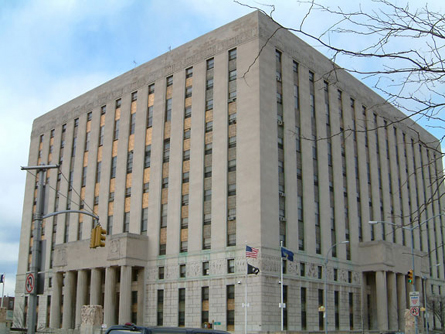
The court system is badly flawed, and those accused of crimes suffer greatly as a result, says David Feige, a former public defender in the Bronx. Mr. Feige wrote about his experiences in the recent book Indefensible, and joined the Gotham Gazette Book Club recently to discuss his views. The following is an edited transcript.
GOTHAM GAZETTE: A big part of your book is about your connection with your clients. Is there a particular client who stands out, where you say "what happened with this person illustrates what I think is wrong with the system"?
DAVID FEIGE: There are lots of clients who do that, but all in different ways. It's hard for me to peg one.
I write about Bemo, a guy from the Bronx who was an inveterate thief. He used to be a big bad gangster in his youth and became a crackhead who I completely loved. He was murdered about three weeks after I wrote about him in the New York Times Magazine, shot in Soundview [housing projects]. I wouldn't say that his life or experience reflects so much on the system, but more that it exemplifies a really difficult concept: Here's this guy who does bad stuff all the time, and he is unbelievably likeable. Beyond likeable. Completely great. He was a pleasure to represent. That is almost nonsensical to a lot of people who see my clients as criminal and never get past that. They don't see them as complex, troubled humans.
A detective told me this great story about how at 2 o'clock one morning he was patrolling Soundview in an unmarked car and sees my client walking down the street with an armful of recently stolen radios. Bemo spotted the car in a second, and he walks over to it, puts down the radios, and says, "Oh, you've got me again." He was so charming about it that the detective said, "I can't arrest him." I like that it wasn't just me. He really was that charming, that interesting. Of course, in a certain way he was also pathetically desperate, drug addicted, and often drug addled. But still completely human.
GOTHAM GAZETTE: Are most of your clients people you see over and over?
DAVID FEIGE: Not most, the volume makes that impossible. I could go into arraignments on a given night, and do 30 cases. But especially if I am doing misdemeanor cases, I will represent one or two of them again or will have represented one or two of them in the past. There is also a core constituency that I was in fairly close touch with for long periods of time.
GOTHAM GAZETTE: You represent both innocent people and those who are guilty, but you mention in the book that it's the innocent ones who break your heart. Can you elaborate?
DAVID FEIGE: All of them break my heart, even a guy who has done some awful stuff. It's awful. By the time I've gotten to trial I know their mothers, I've consoled their siblings. I know their families, their history, their lives. I generally have developed a connection with them, and watching any human dragged off into a cage in handcuffs sucks.
That said, there's something worse about someone who you absolutely believe is innocent. Because no matter how jaded and cynical you are – and I'm reasonably jaded and cynical – you still have some belief that the system is supposed to work out. When it doesn't it is an almost existential crisis, and you always blame yourself. You're their voice, their protector, and when they're convicted it is by and large your fault. There's no way around that. I think about some of the innocent people who are in prison wrongly pretty much every day. They are on my conscience. That's hard to bear.
FORCED TO PLEA BARGAIN
GOTHAM GAZETTE: One issue you deal with in the book is the way that the institutionalized tendency to plea bargain is damaging to defendants. Can you explain how this works?
DAVID FEIGE: Let's assume you're accused of jumping a turnstile, and let's assume you're innocent. You go to court, and the traditional thing happens: The district attorney offers you a trespass violation and one day of community service and it doesn't go on your record. And you say, "But I didn't do it." Your attorney says, "I'm happy to fight the case, but you have to understand it's a very long process."
The judge lets you out, and you come back a month later. You get to court at 9:30 and you sit there. You're not allowed to read, you're not allowed to do much of anything. And you sit there, and you sit there, and you sit there. For hours and hours. Eventually your lawyer walks in, and several hours later your case gets called, [and you stand in front of the judge for three minutes] and says come back in September, and that's it.
So you come back in September, but it turns out the prosecution didn't file the papers. So you come back in October, and then again in November, and pretty soon you've used up a third of your vacation time, and you're getting used to going to the Bronx and sitting there saying "Oh for God's sakes." And your boss says, "what's going on?" And you explain it to your lawyer, and your lawyer says, "I understand, but we're a year and a half away from trial. You have to keep coming back." So you get another court date in December, January, and one in February. But this time your kid's sick, and you call your lawyer and say you can't make it to court, and he says no problem. Then you get a call at the end of the day saying "I'm sorry, but there's a warrant out for your arrest."
Now here you are, a decent citizen trying to fight your case, and there's a warrant out for your arrest. You're freaking out, wondering how this became your life. At some point, you go in and your lawyer says, "Look, this isn't going to go on your record. It's going to take a long time. Maybe I can get you a $50 fine." And you say, "Get me the hell out of here." And you plead guilty, pay a $50 fine, put the whole thing behind you, and pray you never have to come back.
That's all well and good if you never do. But if you live in the Bronx [chances are you'll] get caught up in a sweep in a public housing complex, or something else. Those are arrests. This time the district attorneys say, "You've already gotten your violation; now you have to plead guilty to the misdemeanor." And so on.
Then you have programs like Operation Spotlight. This program is based on the idea that there are a few people who are really bad and commit all these misdemeanor crimes. If you have had a certain number of arrests in a certain period of time you get deemed an Operation Spotlight Offender. You go to a special court with a specially trained judge. Do you know what that means? It's the judge who is just going to ream people out. Talk about how to rig the whole system: You define a category of people, pick a badass judge, and send them to him.
GOTHAM GAZETTE: But the incentive to plea bargain, is this a new thing?
DAVID FEIGE: It's not new, but it's worse here than it is elsewhere. It is a function of the aggressive, broken windows policing style that we've seen in the last decade or so. This has led a huge increase in arrest volume for petty crimes.
There are no questions that in some cases arresting the guy for jumping the turnstile on the train or smoking weed leads to the gun arrest. But my sense is that it is an infinitesimal percentage of those cases. Let's say it was one out of 400. Then the question is how much harm were we doing in the other 399 cases, and was it worth it? I don’t know where I come out on that yet. I'm wrestling with it.
GOTHAM GAZETTE: So if the number of arrests went down, though, that would be the end of it?
DAVID FEIGE: It would have a great effect. But you have to remember how overburdened the system is. There were something like 50,000 misdemeanor cases in the Bronx in 2003, but only 23 jury trials. There were some more bench trials, but still, that's an astonishing number. You have to go a long way to make a dent in the system when you're talking 23 out of 50,000.
They have made structural changes in the Bronx that are speeding up both jury and non-jury trials on misdemeanors, and I'm told to great effect. What they did was deputize all the Supreme Court judges, forcing them to take misdemeanors, which used to all go to criminal court. Supreme Court used to only handle indicted felony cases. Apparently it's having an interesting effect. I don't know the numbers, but the anecdotal evidence is that things have speeded up significantly.
PERCEPTIONS OF THE CRIMINAL JUSTICE SYSTEM
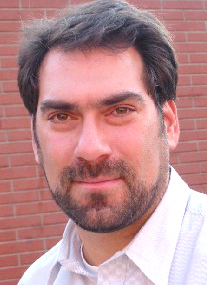 BOB ZANE: Wouldn't you say that there are a lot of assistant district attorneys or law enforcement officers who would be able to write a book from the opposite viewpoint: They're seeing guilty people who they are trying to prosecute – sometimes people who committed serious crimes but have a lot of money – walk free?
BOB ZANE: Wouldn't you say that there are a lot of assistant district attorneys or law enforcement officers who would be able to write a book from the opposite viewpoint: They're seeing guilty people who they are trying to prosecute – sometimes people who committed serious crimes but have a lot of money – walk free?
DAVID FEIGE: The perception is commonplace that guilty people go free on process all the time, that the prosecution is under funded, that the defense is full of high priced fancy pants lawyers. I was a public defender for 15 years. I could bring you up to the Bronx right now, and a tiny percentage of the people there have private lawyers. Probably more than 90 percent of people in the Bronx have public defenders, way more than three quarters in Manhattan have us.
Hiring a criminal defense lawyer is not cheap, and not many people can do it. The reality as I experienced it is that it's the prosecution that has the vast majority of resources. They have the 32,000 members of the NYPD who are their investigative arm; we rely on college interns. When you look at the caseloads at the prosecutors office, they are a fraction of what ours are. We are outmanned and generally over-resourced at almost every staged.
So yes, there are lots of people who can write the opposite book. I would suggest that the opposite book is written all the time. Ed Conlon wrote Blue Blood, which is an interesting portrait. Almost every episode of Law and Order, in many ways, plays into that. You so rarely see public defenders in the public eye. If you watch Law and Order, or pretty much any other TV show, all the defense lawyers are private, fancy suited, big money guys. That's a tiny proportion.
To make a related point, if you were to watch TV, you would think that 80 or 90 percent of the cases in system are rapes or murders. The reality is that there are roughly 600 murders in New York City in a year, and there are 300,000 arrests. What are the other 299,400? There are over 60,000 marijuana arrests in New York every year, but you won't see a weed case on NYPD Blue. They're ignored. There are tens of thousands of trespass cases, but you will never see those on TV. They're not dramatically interesting.
BOB ZANE: You mention when the judges are pro-district attorney. But there are many times when a cop makes an arrest, and the perpetrator walks out quicker than he does. Recently a judge who was kicked out of the bench allowed a person to escape out of her office and get away.
DAVID FEIGE: You're right about that. There are judges who are perceived of – or who are – pro-defense. No question. But once again they are the tiniest minority. Are there a couple? You bet. I love them, I'm grateful for them; they were a little oasis of pleasure.
But that being said, my experience is that the one thing that will get you kicked off the bench quicker than anything else is letting out someone who does something bad again, or being perceived as soft on crime. A judge once called me and said "Dave, the first thing they tell you in judge school is that no one every got kicked off the bench for setting bail too high." That, it seems to me, is the bigger problem.
Have you ever seen the headline: "100 parolees complete parole and go on with their lives"? No. The one we see is "Sex Predator Re-Offends" or "Murderer Released Kills Again." The truth is that's one of a thousand, of ten thousand, of a hundred thousand. But we're led to believe from the coverage that that happens every time. And worse, we legislate from that perspective.
GOTHAM GAZETTE: Do fictional accounts of the criminal justice system contribute to that perception?
DAVID FEIGE: Short answer: yes. It has a terrible, pervasive effect.
I have come to believe, maybe self servingly, that it is critically important to try to change the perception of the criminal justice system, to tell the truth. I don't think anyone is paying attention to the issues I care about. I don't think that anyone is looking at the cases that move me and that are far more predominant than those that do get the attention.
I think the old adage "If it bleeds it leads" has had tremendously detrimental effects on the criminal justice arena at every level. To the extent I can mount a little one-person crusade to mount a counter-narrative, that's what I want to do.
THE PHILOSOPHY OF CRIMINAL JUSTICE
BOOK CLUB MEMBER: I think it's very admirable what you do – in the vast majority of cases, fighting for those who are innocent, and for those who are guilty getting them the right kind of sentence. But what I don't understand about your personal psychology is why you don't feel guilty getting a serious murderer off. Someone like that, in my book, should be in the pen.
DAVID FEIGE: One of the things I tried to make clear in the book is that I don't like it when my guilty clients go away. I like them, and I don't want to see them go to prison. I have real trouble defining someone from one aberrant act.
BOOK CLUB MEMBER: But an aberrant act where they killed someone? That's serious. I'm not talking about trespassing or slapping his wife.
DAVID FEIGE: Let me ask you this: Why should we put them in prison?
BOOK CLUB MEMBER: To keep them off the street.
DAVID FEIGE: For deterrence?
BOOK CLUB MEMBER: For deterrence, and also I'm into punishment.
DAVID FEIGE: If you go through the history of penology, there are various rationales for putting people in cages. One of them is deterrence, which is we're going to do this awful thing to you, and therefore you're going to get scared and you're not going to do it. That's the main argument for deterrence.
In my experience, deterrence doesn't work. It might work with white-collar guys. But most of the guys who I represent didn't do what they did because they were sitting at home poring over maps and rigging alarm systems like they do in heist movies. They were hungry, or they were pissed off. There are million reasons.
When I was in the Bronx, there was one judge who used to ask the defendant in every plea bargain: "Now sir, in your own words what did you do to make you guilty of this crime – and why?" I always prepped my clients to answer this. But if you hadn't, it was almost comical. They would be like "Uh, he looked rich?" It was sort of horrifying, but it reflected something very deep: A lot of my clients don't have a whole lot of insight about their own criminality. They haven't gone through the complex moral calculus that Ken Lay did. My guys, by and large, are not rational actors.
BOB ZANE: A lot of them have mental problems.
DAVID FEIGE: Right. It's stuff that is very deep. It's not the kind of stuff that's easily deterred, and it doesn't matter if the penalty is five days or five hundred years. They're not thinking about that kind of thing.
BOOK CLUB MEMBER: So why have laws then? Why even bother? Why not just survival of the fittest.
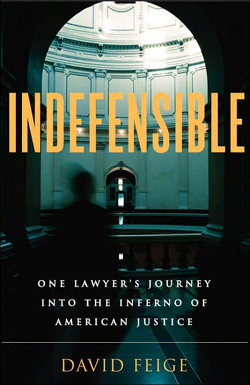 DAVID FEIGE: Well, I'm getting there. So I don't believe in deterrence. The second part of the theory of penology is rehabilitation. I don't believe that prisons rehabilitate my clients in the slightest. I haven't seen it.
DAVID FEIGE: Well, I'm getting there. So I don't believe in deterrence. The second part of the theory of penology is rehabilitation. I don't believe that prisons rehabilitate my clients in the slightest. I haven't seen it.
The last pillar of justification for incarceration is incapacitation: these guys are really bad, vicious, sociopathic predators who will continue inflicting murder and mayhem on society until you lock them in a cage forever. That's the only one I buy, and I have represented a few people who I feel that way about, but they are a tiny number. I came to like them also. That being said, I didn't cry as much for them.
Let's take the toughest case, the hardest example from my entire career: There was a pattern robber who used to jack gypsy cabs for their Motorola radios, which are very valuable on the street. It was clear to me that he was a bad guy, and there was no question that he was going to keep doing it. I represented him in a couple of robbery cases in which he was acquitted, walked out, and went back to robbing people. He eventually got convicted and got 20 years.
Did I feel bad that more people got robbed? Not really, even though I suspected he would go out and do it again. The prosecution hadn't done its work, they tried to skate on the case because they thought they had it sewn up. They didn't bother to call some of the witnesses, to produce a lot of the evidence. If you want to put that guy in prison, just do the work. If you're not going to, then I'm actually not that bothered by standing up and saying that you haven't proved beyond a reasonable doubt; this is not good enough.
Did I cry when said person got his 20 years? No, I didn't cry. Do I see that as a supreme injustice? No, I don't. He was one of the very few.
GOTHAM GAZETTE: So your philosophy is that defenders feel bad when innocent people get convicted, and prosecutors should feel bad when guilty people go free.
DAVID FEIGE: Yes, I think prosecutors should feel bad when guilty people go free, and I think they do. But I do think that is also part of the problem in a certain way, because then the next time they are inclined not to give you discovery, or over prep the witness. That's a real problem.
Prosecutors and defense are in different ethical positions, from my experience.
JUDGES
GOTHAM GAZETTE: A lot of your book talks about the personalities of judges or prosecutors, and how that affects your clients.
DAVID FEIGE: You mean it's capricious? That is a problem, and as we were discussing, you undoubtedly see both sides: the judges who are unbelievably tough, and those who seem unbelievably lax. Then I look at some judges and are awed at their ability to be fair.
It really does make a difference. It is certainly tragic that I will be back in the pens at 11 o'clock on a Friday night, saying to someone, "Listen, the best thing I can do for your is to bury your paperwork so you don't see this judge. I know you're going to spend another night in a cell, I know you're going to hate it, but he's going to set bail at $1,500 and the guy who is coming in tomorrow is going to let you walk out." There's something wrong with that.
I think that justice has to be flexible – I'm against mandatory minimums and all that – but there's something wrong about how capricious the system has become.
GOTHAM GAZETTE: So how do you change a system where the capriciousness of an individual can have such a large effect?
DAVID FEIGE: I think there's lots of stuff that can be done, but what exactly should we do? I'm not sure. What I do know is that I spent more than a dozen years in a system that has real flaws, and those flaws need to be exposed.
BOOK CLUB MEMBER: Why are judges in office for life?
DAVID FEIGE: Well, New York judges are not, although they are in the federal system.
The constitutional basis was that they should have total job security so that they would not be intimidated by the mob, by us, by the New York Post. They would be able to say, "say whatever you want, I have the job for life, and I'm going to do what's right."
All that changed in the mid 1990s when Judge Harold Baer of the Southern District of New York suppressed about eight kilos of cocaine as evidence, saying that the search of a car in which it was found was completely unjustified. By my look at it, he was completely right on the law. But the backlash was severe and extreme. There were editorials in the New York Post every day for weeks, calling for the impeachment of a federal judge for making what pretty much every legal expert said was a reasonable decision. Some of the right-wing senators and house members introduced a bill to impeach him. It won't surprise you to find that three months later he reversed himself and reopened that case against her. To me, that was when the federal judiciary capitulated to the will of the mob.
Â
State Removes Statute Of Limitations For Rape Cases
New York's criminal law is about to undergo a major change following the legislature's elimination of the statute of limitations for rape cases.
Until now, unless charges of rape were brought within five years, there could be no prosecution. When the new law goes into effect, there will be no time limit in New York State for apprehending, arresting and prosecuting rape in the first degree. This is already the case with murder charges.
While efforts to expand or end the statute are not new, the issue catapulted into public awareness – and became the subject of intense lobbying -- during the 2005 Manhattan trial of People v. Fletcher Worrell. In 1973, Worrell was indicted on charges that he climbed through a bedroom window and raped Kathleen Ham, then 26. Yet, he was on trial more than three decades later.
Worrell first had been tried 33 years ago, in the same courthouse. But that trial resulted in a hung -- or undecided -- jury, and Worrell then was released on bail. He jumped bail and vanished. The presiding judge issued a bench warrant for Worrell's arrest, and he became a fugitive.
In this particular case, the commencement of the first prosecution tolled -- or stopped -- the statute of limitations. Even if the first trial had not taken place, Worrell’s fugitive status, once charges were brought, would have kept the prosecution viable.
Worrell was rearrested in Georgia when he tried to purchase a gun. The required background check revealed the New York warrant, and he was extradited to New York to face the original charges.
In the meantime, damaging DNA evidence implicating Worrell was found. The evidence was not useful 33 years ago, as the science of DNA had not yet developed for forensic purposes.
Even though the statute of limitations did not stop prosecution in the Worrell case, the trial illustrated that someone accused of rape, but arrested six after years after the assault would be free from prosecution under the five-year statute of limitations. This would be the case even though the use of DNA could link a suspect to a crime such as rape indefinitely.
Statutes of limitations in both criminal and civil law refer to the period of time during which an action or prosecution can be brought. While the change removes the statute of limitations in criminal cases, it increases the time limit for civil actions for rape from one to five years.
There have been exceptions to the statute of limitations for certain crimes -- those considered the most serious, such as murder, arson and kidnapping -- but rape was never included in this group of crimes.
Until the women's liberation movement of the late 1960s and early 1970s focused on violence against women and made the issue of rape a top priority, prosecution of rape cases was extraordinarily difficult for the victim. The culture and beliefs surrounding rape made legislators, prosecutors, police, judges and jurors, believe that, when a rape occurred, it must have been the woman's fault; she must have consented or "wanted it." The law also required corroboration by another witness or other evidence that the victim tried to fight off the attacker. The victim's past sexual history and reputation were fair game for cross-examination. And if the assault did not occur between strangers, it was not viewed as rape. What is now known as "date rape" was not acknowledged, and certainly it was not accepted that a woman could be raped by her husband or a prostitute by a "John."
In the 1970s, this began to change, and it became easier to successfully prosecute rape. But in New York, the statute of limitations remained five years.
Susan Brownmiller, author of “Against Our Will: Men, Women and Rape,” which is considered the classic work on the subject of rape, says the change in the time limit should have happened in the 1970s and finally occurred because of an “incredibly active” lobbying effort by the National Organization for Women. Ending the statute of limitations, she says is, “more important now because of DNA. You can eventually find the guy who couldn't be found by other means. "
But criminal defense lawyers, who do not want their clients exposed to arrest, prosecution and conviction indefinitely, disagree. David Feige, a criminal defense lawyer and author of “Indefensible,” says, "There has to be some finality.” He says he is “squeamish” about cases being prosecuted 20 to 25 years after the crime: “It makes it basically impossible for the defendant, because usually the defense will be â€consent,’ and who will remember where they were, what happened? … The accused is effectively prevented from presenting a defense."
Other defense lawyers and civil libertarians are concerned about the increased collection of DNA samples and its implications, such as the use of DNA evidence many years after the fact and invasions of privacy.
New York's statute of limitations has been one of the shortest in the nation. According to NOW New York City, as of 2005, there were 690 rape cases that could not be prosecuted because of the time limit. The change in law, the group says, will "finally bring justice to some victims of rape."
Emily Jane Goodman is a New York State Supreme Court Justice
Picking Supreme Court Judges New York

In January, U.S. District Judge John Gleeson ruled that the current system of nominating State Supreme Court judges in New York is unconstitutional. At a recent forum at the Association of the Bar of the City of New York, a panel of experts weighed in on the subject of how to select judges and why it matters. The following articles are edited transcripts of the event.
Giving Voters Real Choices
Deborah Goldberg of the Brennan Center argues that with certain reforms, primary elections could address many of the current problems in selecting judges. Read more
Selecting the Most Qualified Candidates
Michael Cardozo, the counsel for New York City, argues that while merit selection is the best way to appoint judges, screening panels that recommend the best judicial candidates is the most practical approach. Read more
Creating A Diverse Judiciary
Paul Wooten, who has served as a delegate to Brooklyn’s Democratic judicial convention, argues that, for the most part, the current system works and elects judges that represent the diverse city. Read more
Â
Mafia: Rise, Fall and Resurgence
Selwyn Raab recently met with Gotham Gazette's Reading NYC Book Club to discuss his book Five Families: The Rise, Fall and Resurgence of America's Most Powerful Mafia Empires, a history of the Mafia from its origins in Sicily to the present day. The following is an edited transcript of the event.
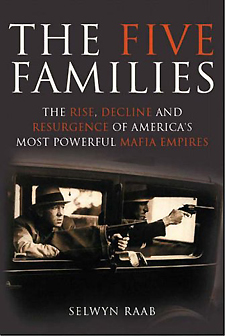 GOTHAM GAZETTE: Mr. Raab, your book focuses largely on the fall of the New York crime families, but the title includes the phrase "resurgence." What's going on with the Mafia in New York City right now?
GOTHAM GAZETTE: Mr. Raab, your book focuses largely on the fall of the New York crime families, but the title includes the phrase "resurgence." What's going on with the Mafia in New York City right now?
SELWYN RAAB: Up until 9/11, there had been a 20-year long, concentrated attack against the Mafia, based on the Racketeer Influence Corruptions Act, popularly known as RICO. What was important about RICO was that for the first time it gave prosecutors an effective tool to go after the big shots in organized crime. At the attack's peak, there were 200 people working full time on just investigating the five Mafia families in New York -- the Gambino, the Bonano, the Colombo, the Lucchese, and the Genovese. The FBI had a specific squad following each family, and were able to bust John Gotti, Vincente "The Chin" Gigante, and other bosses, even though they didn't pull a trigger or shake anyone down themselves.
[This prosecution was coupled with a] concentrated effort to knock the Mafia out of some industries. Waste collection and construction were two immense moneymakers for them, and they've been hurt in both industries, especially commercial garbage collection. There is now some oversight by city agencies, licensing etc. The Mafia has been severely wounded in some of these big industries – but not mortally.
As soon as 9/11 occurred, terrorism justifiably became a prime concern and objective for the FBI and most police departments, including New York's. This created a reprieve – suddenly you had this tremendous diminution of people investigating the mob.
Today, the Mafia is still making money in gambling and loan sharking. The penalties for these crimes are very small, nobody goes away for a long time, and bosses are never brought up on charges. Still, this is terrific seed money to keep them going.
The Mafia is still very big on Wall Street, counterfeit credit cards, and phone scams. But a lot of the most recent action has been in the suburbs, where the theory is the local police departments don't have the expertise to stop them.
FORMING THE MAFIA
GOTHAM GAZETTE: Is there a fundamental difference between the Mafia and other types of organized crime?
SELWYN RAAB: We've always had organized crime groups – you had Irish and German gangs on the Bowery, Jewish bootleggers, the Italians, and so on. To oversimplify, prohibition changed all these gangs from street thugs to executives. The money was so big that they could expand, and when prohibition ended, they had big organizations to go into different things like labor racketeering.
But the Italians had a business genius named Charles "Lucky" Luciano. Luciano saw the handwriting on the wall – prohibition was going to end, and what were gangs going to do for loot? He also saw the lack of a central organization. Luciano had a major convention [of Italian gangs] in Chicago in 1931, and said we can't have fights among ourselves anymore, because it's bad for business. He turned the Italian gangs into a semi-military organization based on what had been going on in Sicily, where each family had a boss, underboss, consigliere, and soldiers.
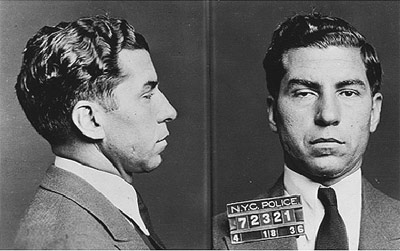
Charles "Lucky" Luciano
If you knocked out the leaders of the Jewish or Irish gangs, they dissolved, because there was no military setup. But Luciano set up the Mafia so that the individual is secondary to the organization; the theory was that the organization had to survive at any cost. If the boss died or was arrested, the organization replaced him, and he set up another hierarchy.
To stop disputes between families, Luciano created something called the Commission comprised of representatives from each of the five New York families. Immediately, they had more power than anyone else in the country.
Luciano also urged the Mafiosi to diversify their activities. Instead of having just gambling or loan sharking as other gangs did, they went into labor racketeering. They were a mirror image of capitalism: whatever works.
That distinction still exists today. The Mafia has such a lot going for it. The Latin Americans – Columbians and Mexicans – are into one thing: narcotics. They don't have the know-how to do these other kinds of crimes. Same thing with the Asian gangs, the Chinese. They may be involved in smuggling immigrants, or do shake down rackets on stores or restaurants in Chinatown and Queens. But they're not involved in other things.
THE IMPACT OF ORGANIZED CRIME ON NEW YORK CITY
GOTHAM GAZETTE: Why did New York City's Mafia families have such a disproportionate amount of power within the nationwide Mafia right from the beginning?
SELWYN RAAB: We can thank Benito Mussolini partly for this. The Mafia had always been very strong since it started out in Sicily in the 18th century, where people once thought of them as liberators because they fought against the foreign invaders, protecting the small farmers, peasants, and businessmen. They developed into a tyrannical organization, and they grew very powerful both politically and financially. When Benito Mussolini came into power, he saw them as a threat and started a crackdown. He rounded people up and put them in cages, sent them away for life, or killed them.
Because of this, a lot of the young Mafiosi in the 1920s emigrated to the United States, and the major place they went was New York City. They liked New York. It was very profitable. There was a big Italian American population, bigger than anywhere else. They settled into New York because they were welcomed here.
The curse of New York is that there are still five powerful Mafia families here. In the rest of the country it wasn't that hard to combat the Mafia – you just had to knock off one family and there would be no one around to fill their shoes. Here, if there is a devastating blow to one family, that vacuum can be filled by one of the others. They know if it's a good opportunity, and they'll take advantage of it.
PHILIP ANGELL: In New York City organized crime families were involved in a lot of very public rackets – the trash business, the construction business, the ready-mix concrete business. These were pretty open secrets for a long time. Do you have any sense of why this was tolerated by the political, financial, and law enforcement establishment?
SELWYN RAAB: Well, one major reason was that J. Edgar Hoover didn't want the FBI to do anything with the mob. They didn't do anything until after his death in 1972.
I started as a reporter in New York in the 1960s on the education beat. I was working for a year when there was a big scandal: schools were falling apart. I was assigned to the story and found so many connections. There were secret Mafia partners to all these construction firms that were allowing ceilings to collapse, and building shoddy buildings. There was a big investigation, and eventually the city got rid of some of the people who worked for the Board of Education and banned some of the contractors. But they never went after the Mafia.
So I started asking around: Why don't you do anything about the Mafia? "It's too hard," I was told. But the real reason was that the Mafia was paying off the politicians and the judges. Every stone you turned up in this town had to do with the Mafia. Garbage, the fish market, you name it.
Also, when you talked to mayors off the record they'd say: 'everything runs smoothly now. If you fool around with the construction industry, there will be a strike. If you do anything about trying to regulate the garbage industry, they won't pick up the garbage. If you try to do anything about the fish market, restaurants won't get any fish. Leave well enough alone. They're not bothering anybody.'
GOTHAM GAZETTE: Can you point to any industries that the Mafia ruined or ran out of town?
SELWYN RAAB: I used to speak to people in the garment center, and they said you had a choice: either you get protection from the mob, or you sign up with the union and pay the union dues. The union will let you be non-union, but you have to be hooked up with some family. In fact, the corrupt unions were getting part of the payoffs.
There were mob families running all the trucking in the garment center – the Colombos and the Luccheses. You couldn't be an independent trucker and go into the garment center. You'd have flat tires, and your drivers would be beaten up. These weren't the only reasons – there were runaway industries for cheaper labor elsewhere, too– but they added an extra inducement. Why bother?
It wasn't just the garment industry. Garbage haulers wouldn't come into New York because they knew it wasn't worth the effort. If you came in you'd be shaken down, and if you didn't pay them off there would be a strike, because they controlled the Teamsters on the garbage locals.
A lot of fish wholesalers wouldn't come into New York for many years. They would rather go to New England, or the big fish markets in Baltimore, where they wouldn't have this trouble.
PHILIP ANGELL: And the important thing to remember is that it was underwritten by violence, no matter what industry.
ROMANTICIZING THE MOB
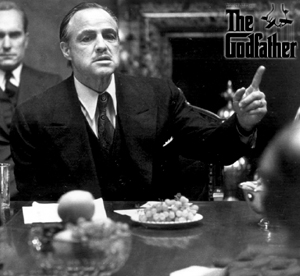 GOTHAM GAZETTE: Why do people have such a romantic view of this?
GOTHAM GAZETTE: Why do people have such a romantic view of this?
SELWYN RAAB: Well, that's Hollywood. American entertainers have always had a vicarious love affair with criminals. They're interesting people; you're more interested in rogues than good guys. Do you want to do a story about the founder of the Red Cross or Salvation Army? No one is too interested in that.
One of my pet peeves is a movie like the Godfather, where we set up the idea that there are good Mafiosi and bad Mafiosi. Don Vito Corleone, played by Marlon Brando, he's a white hat, a good guy cowboy. At one point, he's opposed to narcotics, and as a result there's an attempt on his life by the bad Mafiosi. But who wins? The good guys.
They try to create this image that it's not so simple, that you can identify with them.
I don't watch the Sopranos every week, but when I do watch what I see is a soap opera not about a mob family, but a dysfunctional suburban family. If you're a middle-aged man, you can easily identify with Tony Soprano. His kids are rebelling against him, his wife is smarter than him and wants to leave him, he doesn't have the old time loyalty when he goes to the office anymore. He has all these midlife crises, even though he lives in a mini mansion, has a harem of beauties throwing themselves at him, and he's got big cars and all the money in the world. Yet he's got these crises; you can sympathize with him. You don’t see him for the most part killing people.
You get a vicarious kick out of watching these people. Look at the great lives they lead: they sleep late, they don't have to go to work, they make a lot of money, they have a lot of woman friends. It looks good.
There's one other aspect which I think is a subtext to all of this, which makes these movies popular and is why people romanticize the Mafia: they're antiestablishment. In the Godfather, they talk about how the Italian Americans couldn't get a break. They had to become a government onto themselves, because the WASP establishment wouldn't allow them to become bankers or big businessmen. You can see it also in the Sopranos. His father was a laborer. What a choice: drive a truck for a living, or could he work for the mob and make a lot of money, be comfortable, take care of your family?
GOTHAM GAZETTE: But how much of that is true?
SELWYN RAAB: Well, I've talked to a few made men. They always rationalized what they did and why they did it. But they have always been into anything that will bring them money.
Â





